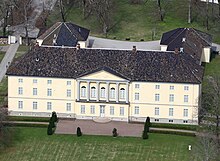Gut Jarlsberg
Gut Jarlsberg is a former crown estate in the municipality of Tønsberg , Norway , and is known today as the stately manor of the Count Wedel- Jarlsberg.
The “Sem” estate, which had previously belonged to the Tønsberg Provost, was confiscated by the Danish-Norwegian king during the Reformation and some surrounding farms were added.
The county
In the course of an exchange of goods, the bailiff of Tønsberg and later Prime Minister of Denmark Peder Schumacher Griffenfeld , who had been raised to the rank of count in 1671, received this crown property in 1673, which has now been renamed "Griffenfeldgård". It is the second and last county (after Laurvig (= Larvik ) county from 1671). In 1675 the estate was expanded and was named "County Tønsberg". Griffenfeld was also given the feudal lord's seat "Sem", which was now called Griffenberggård. Griffenfeld had the right to appoint for all churches in the county and for the church Slagen bei Tønsberg, the right to appoint for all offices in the county and the income from many public taxes. The count later acquired ownership of all of the county's churches. The count owned 14% of the property. The county stretched from Drammen in the north to Tassebek in Stokke in the south.
After Griffenfeld's conviction in 1676, the estate was confiscated and the owner of County Laurvig, the governor Ulrik Fredrik Gyldenløve, was enfeoffed with him . In 1683 he sold the county under the name "Grafschaft Jarlsberg" to Field Marshal Gustav Wilhelm Graf Wedel . His descendants still own the county today. Due to the nobility law of 1821, with the death of the last Count Peder Anker Wedel Jarlsberg in 1896 , it ceased to be a county. It became the parent house for all members of the Wedel-Jarlsberg family with elder inheritance. With legal succession regulation at the request of the owner Carl Nicolaus Wedel Jarlsberg, the law of 1927 limited the succession to the male descendants of the current Norwegian line. This law excluded the numerous descendants living in Germany from the right of entry. The law also stipulated that if the male line died out, the headquarters of the University of Oslo should fall. The 1999 law reintroduced female succession. The real estate did not stay with the owners. Rather, churches and land were allowed to be sold in 1750, so that land ownership in 1775 fell from 14% to 5%. The Family Fideikommiss Jarlsberg was handled like all Fideikommiss in Scandinavia. But it has a unique legal position in that it has the only elder inheritance that has been legally upheld.
The parent company
Jarlsberg's ancestral home is located on the site known as Sæheim (Sem) from the saga times. There sat after the Ynglinga saga of Snorri Sturluson, the small king over Vestfold and Romerike Øystein Halvdansson († 770). The oldest still existing system is "Farmannshaugen", a large burial mound that is said to have been built for the son Harald Hårfagres Bjørn Farmann († 927), little king of Vestfold. However, excavations have shown that there is no grave in the hill. Under the east wing of the current building there are vaults from the Middle Ages in which Erik Blutaxt is said to have killed his brother Bjørn Farmann. The feudal lord provost Knudsen Hørby began to repair the building in 1636. The house consisted of four wooden wings around a paved inner courtyard. The building burned down in 1682. The new owner, Graf Wedel, built a new one-story stone house with four wings and four corner pavilions, which was completed in 1701. Count Frederik Christian Otto Wedel (1718–1776) raised the main wing to two floors with a large knight's hall. Count Johan Caspar Herman Wedel-Jarlsberg (1779–1840) rebuilt the entire palace in Empire style when he took over the county in 1811. The north wing was torn down, the knight's hall restored and the main building was given the appearance that still exists today. In 1939 it was placed under monument protection.
The park was laid out in the French style around 1720. In 1840 it was changed to the pattern of English parks. The park includes wooded areas and “Store and Lille Gullkronen” with the family burial site.
literature
- Terje Bratberg: Jarlsberg . In: Store norske leksikon
- JFW Haffner, M. Haffner: Jarlsberg Grevskab . In: Christian Blangstrup (Ed.): Salmonsens Konversationsleksikon . 2nd Edition. tape 12 : Hvene – Jernbaner . JH Schultz Forlag, Copenhagen 1922, p. 844 (Danish, runeberg.org ).
Coordinates: 59 ° 17 ′ 19 ″ N , 10 ° 23 ′ 7.9 ″ E


